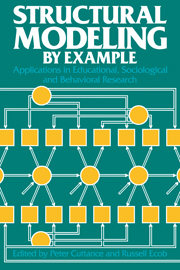Book contents
- Frontmatter
- Contents
- Preface
- List of contributors
- 1 Introduction
- 2 An overview of structural equation modeling
- 3 Field dependence and the differentiation of neurotic syndromes
- 4 High school seniors' reports of parental socioeconomic status: black–white differences
- 5 Modeling the hierarchical structure of learning
- 6 A study of longitudinal causal models comparing gain score analysis with structural equation approaches
- 7 Some structural equation models of sibling resemblance in educational attainment and occupational status
- 8 Applications of structural equation modeling to longitudinal educational data
- 9 The robustness of maximum likelihood estimation in structural equation models
- 10 An inquiry into the effects of outliers on estimates of a structural equation model of basic skills assessment
- 11 Testing structural equation models
- 12 LISREL models for inequality constraints in factor and regression analysis
- 13 Issues and problems in the application of structural equation models
- Appendix
- Glossary
- Index
11 - Testing structural equation models
Published online by Cambridge University Press: 12 January 2010
- Frontmatter
- Contents
- Preface
- List of contributors
- 1 Introduction
- 2 An overview of structural equation modeling
- 3 Field dependence and the differentiation of neurotic syndromes
- 4 High school seniors' reports of parental socioeconomic status: black–white differences
- 5 Modeling the hierarchical structure of learning
- 6 A study of longitudinal causal models comparing gain score analysis with structural equation approaches
- 7 Some structural equation models of sibling resemblance in educational attainment and occupational status
- 8 Applications of structural equation modeling to longitudinal educational data
- 9 The robustness of maximum likelihood estimation in structural equation models
- 10 An inquiry into the effects of outliers on estimates of a structural equation model of basic skills assessment
- 11 Testing structural equation models
- 12 LISREL models for inequality constraints in factor and regression analysis
- 13 Issues and problems in the application of structural equation models
- Appendix
- Glossary
- Index
Summary
Introduction
An important use of structural modeling is the testing of theories. The plausibility of hypotheses concerning causal mechanisms depends on the empirical support they receive from data. Thus, any technique that analyzes causal structures should include a means of assessing the disagreement between the model and the data. However, even when a test of the agreement between the data and the theoretical model is available, we also require a means of assessing the probability that the results are due to characteristics of the research design itself. There must be a reasonable chance of rejecting incorrect theories independently of the research design. The probability of rejecting an incorrect model is referred to as the “power of the test.” Structural modeling provides estimates of the model parameters and a formal test for deciding whether a theory should be rejected, given the data. However, the standard use of the likelihood ratio test statistic is not without problems. In the case of a large sample, the test very often leads to rejection, whereas in the case of a small sample the test rarely leads to the rejection of the model. Other indices of model fit have been suggested (Wheaton et al. 1977; Bentler & Bonnet 1980; Fornell & Larcker 1981; Hoelter 1983) that take into account the impact of the sample size on the test; however, the efficacy of all of these indices depends on the power of the test. Satorra and Saris (1982a, b) have developed a procedure to determine the power of the likelihood ratio test in structural models.
- Type
- Chapter
- Information
- Structural Modeling by ExampleApplications in Educational, Sociological, and Behavioral Research, pp. 202 - 220Publisher: Cambridge University PressPrint publication year: 1988
- 4
- Cited by



